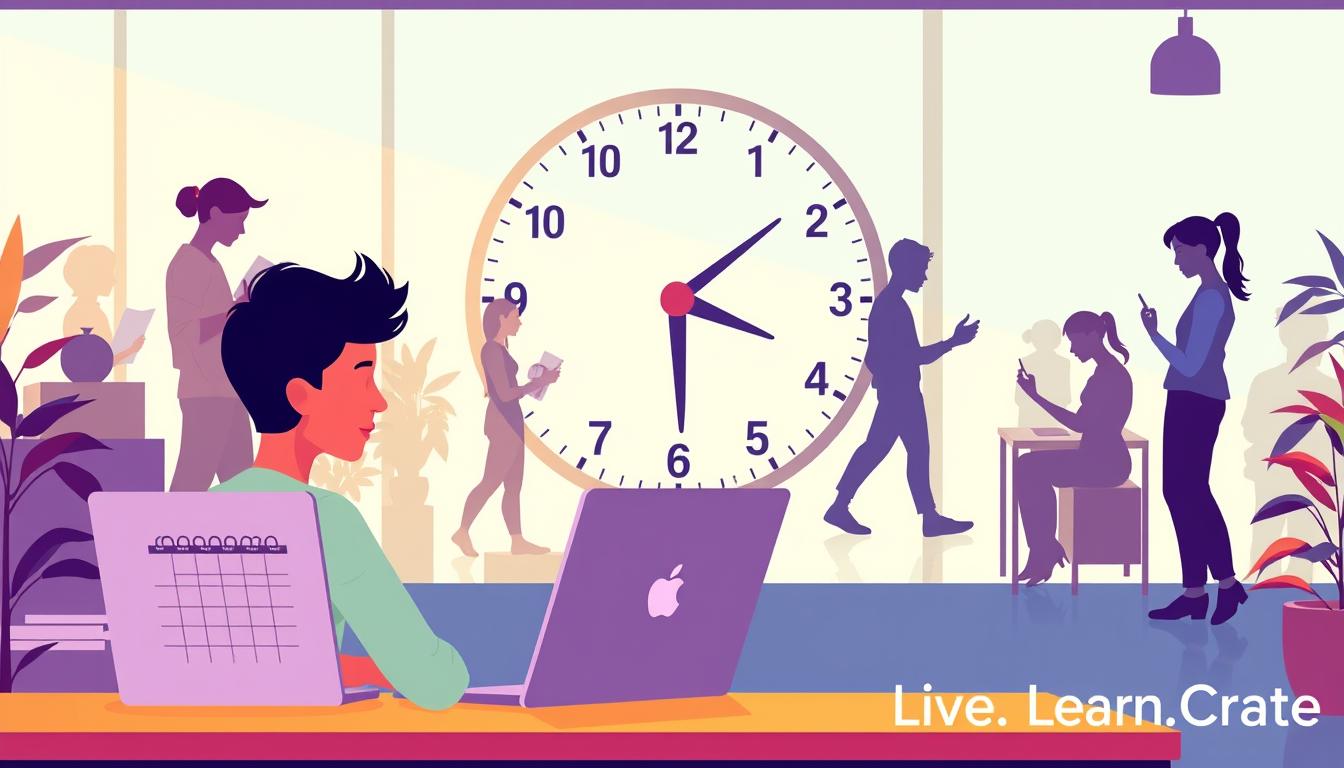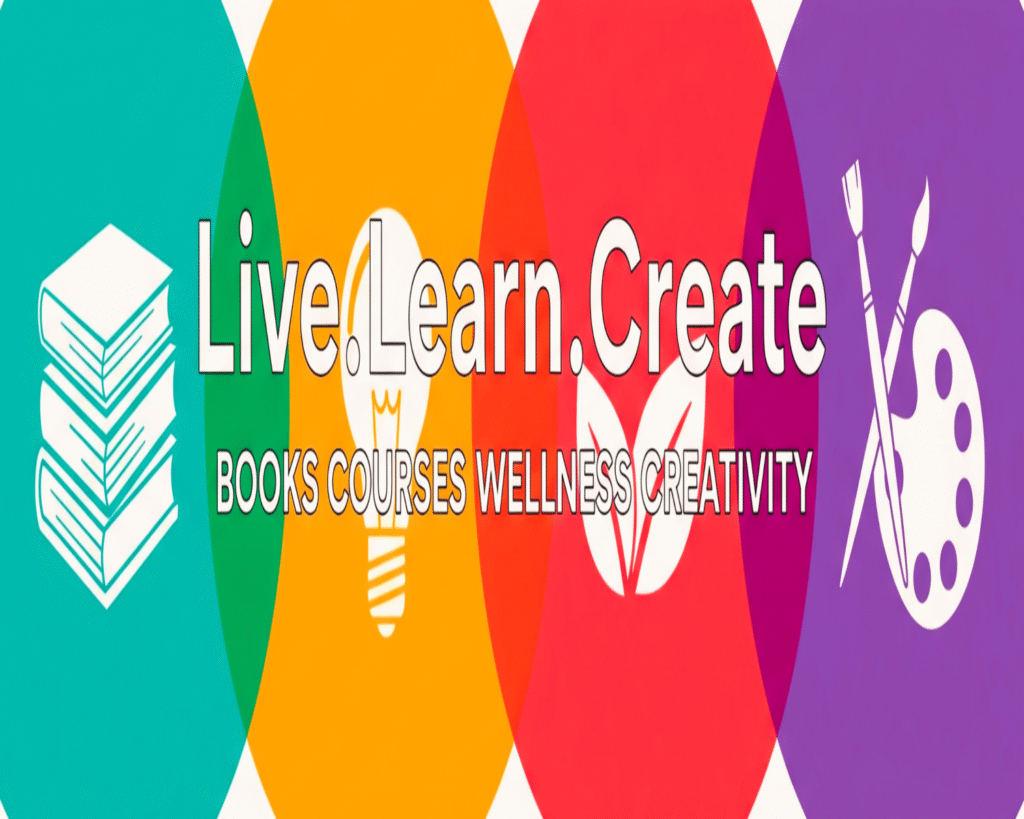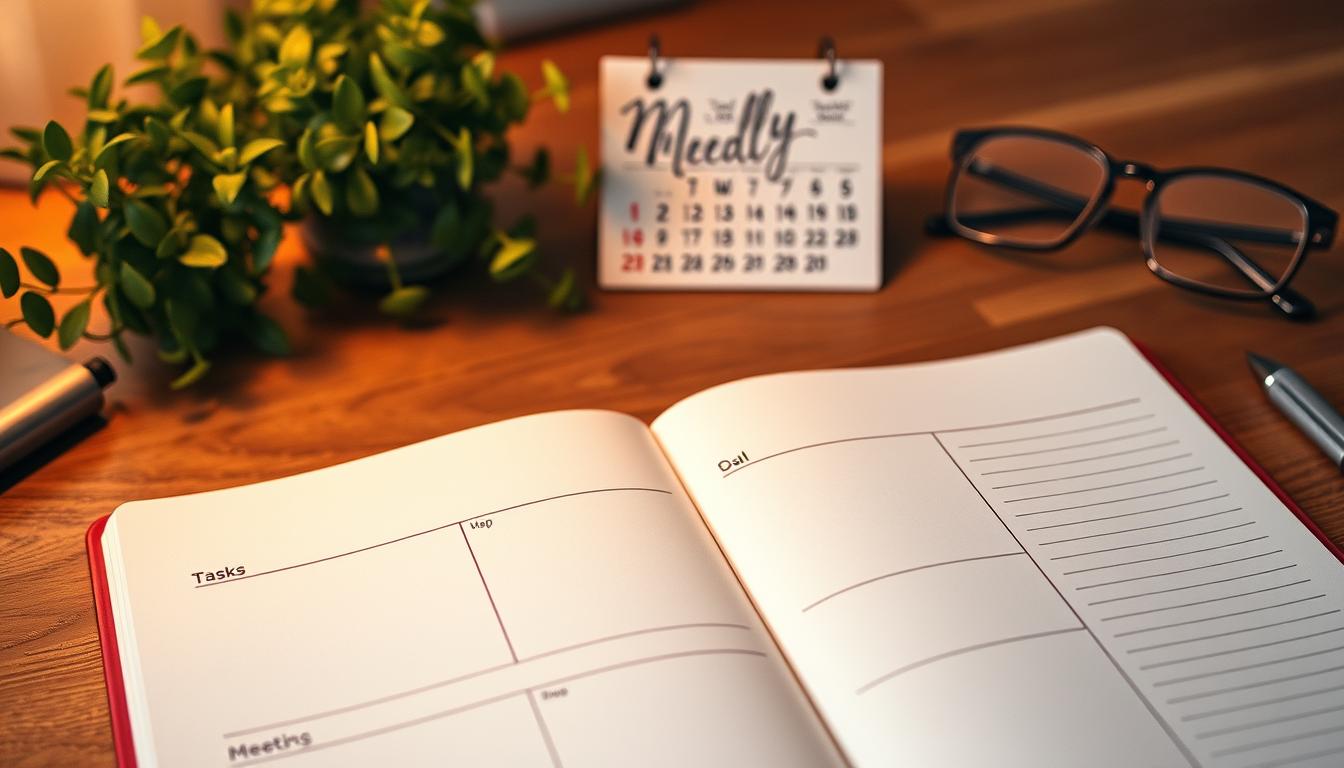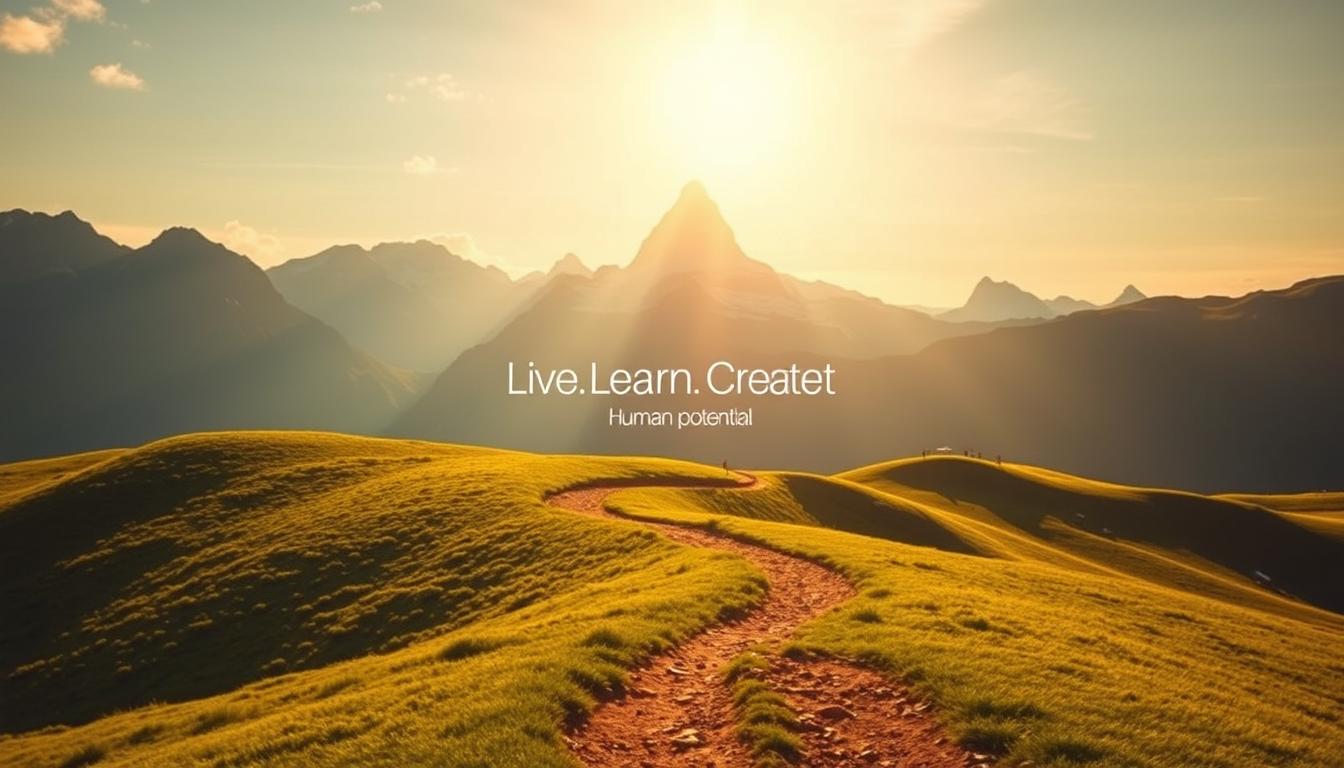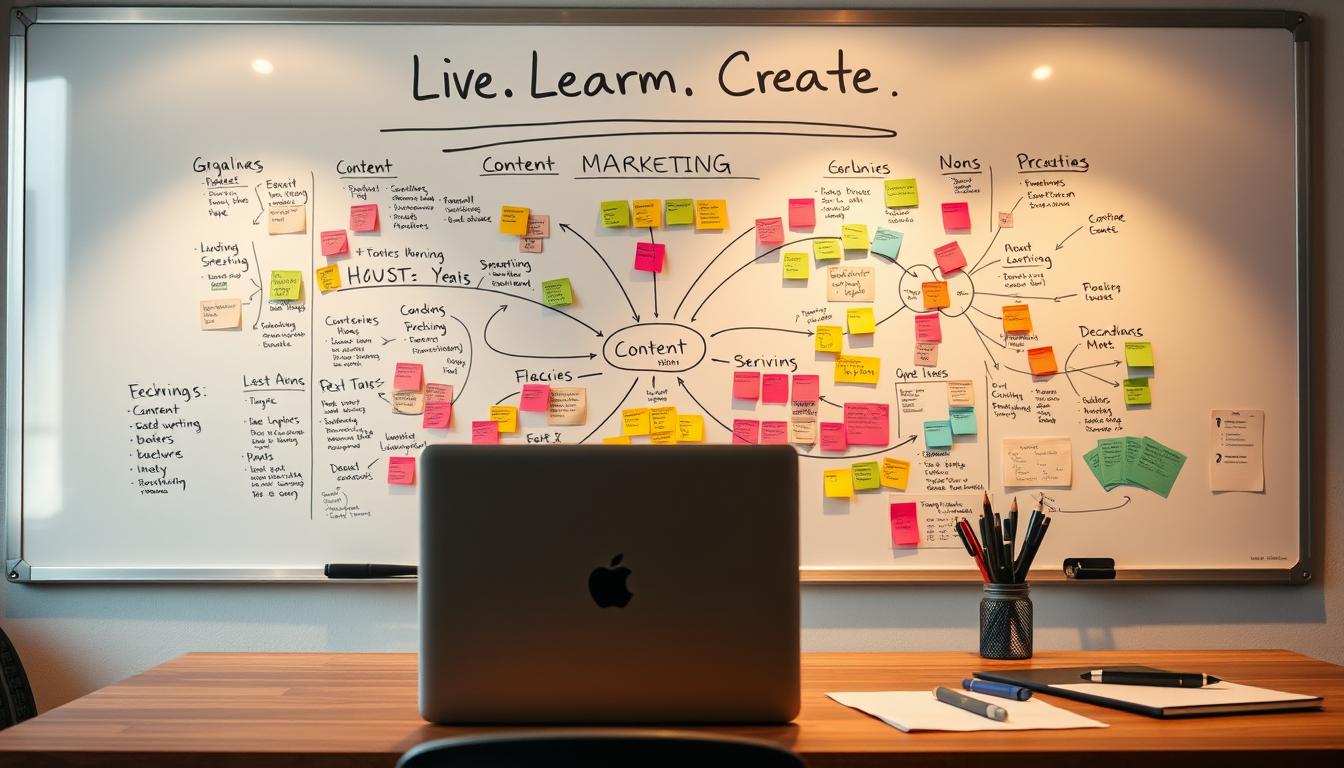“It is not that we have so little time, but that we lose much of it.” – Seneca’s ancient wisdom feels strikingly modern in our busy lives. What if reclaiming your hours wasn’t about working harder, but choosing smarter?
Imagine ending each day with quiet confidence instead of exhaustion. This journey isn’t about rigid schedules or endless to-do lists. It’s about creating space for what truly matters to you – whether that’s career growth, family moments, or personal renewal.
We’ll explore how intentional planning helps you honor priorities without burnout. You’ll learn to distinguish urgent tasks from meaningful ones, using methods that adapt to your unique rhythm. Forget squeezing more into your day – we focus on aligning actions with your core values.
Through compassionate self-reflection and practical strategies, you’ll build habits that support both professional drive and personal joy. Let’s discover how mindful choices create that satisfying click of a well-spent day.
Key Takeaways
- Prioritize what aligns with your values, not just deadlines
- Create daily rhythms that reduce stress and increase fulfillment
- Balance responsibilities with self-care through intentional planning
- Develop adaptable systems instead of rigid schedules
- Celebrate progress, not perfection, in your journey
Understanding the Fundamentals of Time Management
The secret to a fulfilling day lies not in doing more, but in doing what matters most. Imagine holding a compass that points to your true north—values, energy peaks, and personal goals—instead of chasing every demand that shouts for attention.
At its core, effective planning asks us to distinguish between urgent demands and meaningful progress. What feels pressing might not align with your deepest priorities—that email can often wait while creative work deserves prime energy. “Productivity grows when we water our strengths,” as one mindfulness coach observes.
Your natural rhythm holds the key. Are you a sunrise strategist or a night owl creator? Building daily patterns around these energy surges transforms effort into flow. Track your focus windows for a week—you might discover hidden pockets of potential.
Realistic planning becomes your ally here. Overestimating capacity leads to frustration, while underscheduling leaves goals gathering dust. Start by blocking 25% fewer tasks than you think possible. This space becomes your buffer for life’s beautiful unpredictability.
True balance emerges when we honor both action and restoration. Schedule that midday walk as fiercely as you protect meeting times. Your best work blooms from roots of self-care and clear intention.
Defining Effective Time Management Techniques
What if your daily rhythm could feel less like a race and more like a dance? True productivity blossoms when methods enhance rather than restrict your natural flow. The magic happens when chosen approaches become invisible allies—quietly supporting your priorities without demanding constant attention.

What Makes a Technique Effective
Great methods feel like comfortable shoes—supportive but never pinching. They work best when they:
- Match your existing strengths (like using visual thinking for color-coded systems)
- Offer gentle skill-building opportunities
- Create breathing room instead of rigid rules
Consider how delegation skills amplify the Getting Things Done method, or how creative minds thrive with mind mapping. “The right approach should whisper guidance, not shout commands,” observes a mindfulness coach we surveyed.
Adapting Techniques to Personal Needs
Your life isn’t a textbook case—and your methods shouldn’t be either. Start by identifying one pain point: maybe constant interruptions or evening energy slumps. Try adjusting a proven method to address that specific challenge.
If the Pomodoro technique’s 25-minute sprints feel too short, experiment with 45-minute focused blocks. Love lists but hate digital tools? Craft a beautiful analog system using colored pens and a notebook you enjoy opening.
Remember—this is about progress, not perfection. Celebrate when a tweaked method helps you finish work earlier to watch the sunset. That’s real success.
The Role of Time Management Strategies in Everyday Success
What if your calendar became a canvas for meaningful moments rather than a battlefield of obligations? True time management strategies act as gentle guides—helping you allocate hours in ways that honor both responsibilities and dreams. They’re not about squeezing more into your day, but ensuring each action resonates with your core values.
Think of these approaches as flexible scaffolding. A teacher might blend “getting things done” methods with weekly reflection rituals, while a parent could pair priority-filtering skills with spontaneous family time. Management strategies thrive when tailored to your unique rhythm—like adjusting workout times to match energy levels or blocking creative work during mental peak hours.
Success here isn’t measured by crossed-off tasks alone. It’s found in that quiet pride when you finish work early to attend your child’s recital, or the peace of mind from knowing urgent emails won’t hijack your morning meditation. These frameworks help you manage time while leaving room for life’s surprises—a cancelled meeting becomes space for a walk, not wasted minutes.
The magic happens when strategies evolve with you. What worked during career-building years might shift when focusing on health or relationships. By regularly checking if your methods still serve your current priorities, you cultivate resilience against overwhelm and create days that feel purposefully yours.
Crafting a Balanced Daily Routine with Prioritization
Picture your day as a mosaic where each tile represents what fuels your purpose. A well-crafted routine blends professional duties with soul-nourishing moments—not through rigid control, but thoughtful alignment.

Start by designing your to-do list like a curated gallery. Include both work tasks and personal commitments—that morning project review deserves space alongside your afternoon walk. Try this approach:
- Divide tasks into “Foundations” (must-do items) and “Growth” (value-aligned goals)
- Rank them by impact, not convenience
- Leave white space for unexpected joys
Many stumble by prioritizing quick wins over important tasks. Ask: “Will this choice matter in six months?” Your energy peaks become sacred hours for high-value work, while routine items wait for lower-focus periods.
True balance thrives on compassionate flexibility. When meetings overflow, adjust your list without guilt—completed items aren’t trophies, but stepping stones. One entrepreneur we coached found freedom by scheduling “priority protection windows” twice daily.
Remember, your routine should breathe like living art. Some days will shine with productivity; others whisper for rest. Both belong in your masterpiece.
To-Do Lists and Prioritization: Organizing Your Tasks
What if your task list could breathe with you—expanding and contracting with life’s natural rhythm? A well-designed to-do list becomes more than a reminder—it transforms into a compass pointing toward what truly matters. Let me show you how this simple tool can ease mental clutter while honoring both your professional drive and personal dreams.
Start by writing down both professional duties and personal aspirations in one space. This fusion creates clarity—you might notice that afternoon meeting could shift to protect your morning creative surge. “Your list should reflect your whole self, not just your job title,” notes productivity coach Mara Lin.
Treat your list as a living document. Review it with morning coffee and evening reflection—cross off completed items with satisfaction, but leave room for adjustments. Unexpected opportunities often deserve priority over rigid plans.
Here’s the secret: organize work by energy required rather than urgency. Place high-focus tasks during your peak hours. Save routine items for when your brain needs a break. This approach helps prioritize tasks that align with long-term goals while managing daily demands.
Celebrate progress over perfection. Some days you’ll check off ten items—others, just two meaningful ones. Both count as success when your choices mirror your values. What matters isn’t completing every task, but moving closer to your vision with each checked box.
Overcoming Common Time Management Challenges
Let me assure you—distractions don’t mean you’re failing. They reveal opportunities to design smarter workflows. When your phone buzzes during focused work, it’s not a moral crisis—it’s a signal to adjust your environment.

Start by mapping your distraction patterns. Do scrolling habits peak mid-morning? Does perfectionism stall progress? These aren’t flaws—they’re clues for creating personalized solutions. One graphic designer we coached replaced social media checks with quick nature sketches during creative blocks.
Try this simple table to reframe challenges:
| Challenge | Root Cause | Solution |
|---|---|---|
| Social media scrolls | Seeking quick dopamine | Schedule 10-minute “connection breaks” |
| Perfectionism paralysis | Fear of imperfection | Set “good enough” deadlines |
| Task overload | Unclear priorities | Use morning priority filtering |
Digital boundaries become easier with compassionate tech habits. Turn off non-essential notifications—your best work deserves undivided attention. Free apps like Forest help stay present by growing virtual trees during focused sessions.
Remember—progress lives in small wins. Completed three tasks before noon? Celebrate that focus. Protected thirty minutes for lunch away from screens? That’s victory. Your capacity grows through consistent kindness, not harsh demands.
What matters isn’t eliminating all distractions—it’s building resilience to return to what matters. Each mindful choice to spend time intentionally strengthens your focus muscles. You’ve got this.
Tackling High-Value Tasks with the Eat That Frog Approach
What if conquering your toughest challenge could set the tone for an effortless day? Mark Twain’s wisdom—“Eat a live frog first thing”—offers more than productivity advice. It’s about building momentum through courageous starts.
The most demanding task often holds the key to your progress. By addressing it early, you create psychological ease—subsequent work feels lighter. This isn’t about punishment, but freeing mental space for what matters.
Try this compassionate approach:
• Identify one “frog” each evening—a project requiring deep focus
• Schedule it during your natural energy peak (even if not morning)
• Celebrate completion before moving to simpler tasks
I’ve seen clients transform when they stop postponing hard work. A writer finally drafted her book’s introduction at dawn. A manager tackled budget reviews before emails. Their secret? Progress fuels motivation more than checking off easy wins.
Remember—this method adapts to your rhythm. Night owls might “eat frogs” after dinner. Parents could use naptime for focused work. What matters is honoring your capacity while gently stretching it.
Each completed challenge becomes a stepping stone. You’ll discover how important tasks done with intention create ripples of confidence through your day.
FAQ
How do I choose the right strategy for my work style?
Start by identifying your energy patterns and priorities—experiment with methods like time blocking or the 80/20 rule. Track what helps you complete high-value tasks without burnout, then refine your approach weekly.
What’s the best way to handle urgent requests during focused work?
Protect your deep work sessions by setting clear boundaries. Use a “pause-and-plan” technique: jot down incoming tasks on your to-do list, then address them during designated buffer times later in the day.
Can digital tools truly improve how I organize my day?
Absolutely—apps like Todoist for task prioritization or Toggl for tracking daily progress create visual accountability. Pair them with analog methods like handwritten weekly reviews for balanced productivity.
How do I maintain momentum when routines feel repetitive?
Build flexibility into your schedule using theme days (e.g., Creative Mondays, Administrative Wednesdays). Celebrate small wins through progress tracking, and revisit your goals monthly to stay aligned with what matters most.
Why does the “Eat That Frog” method work for challenging projects?
Tackling your hardest first thing morning leverages peak mental clarity. This approach reduces procrastination by transforming daunting tasks into completed milestones, creating positive momentum for the rest of your day.
Transform your home into a more peaceful and mindful sanctuary. Creating a Zen-inspired home environment is a core part of the “Live.Learn.Create” theme, focusing on peace, mindfulness, and a clutter-free space. Here is a curated list of Zen home items.
The Zen Essentials
These items are the building blocks of a calm, intentional living space.
- Candles & Scents:
- Scented Candles: Look for calming, natural scents like sandalwood, lavender, white tea, or bergamot. Choose candles made with soy or beeswax for a clean burn.
- Essential Oil Diffusers: A minimalist, sleek diffuser made of bamboo, ceramic, or glass.
- Essential Oil Sets: Look for blends specifically for relaxation, focus, or sleep.
- Incense & Burners: Natural incense sticks (e.g., palo santo, sage) with a simple, elegant burner.
The Zen Decor
This is about incorporating natural elements and simple design.
- Natural Materials:
- Wood or Bamboo Trays: For organizing candles, stones, or other small items.
- Ceramic Vases: Simple, unglazed ceramic vases in neutral colors like white, beige, or gray.
- Minimalist Art: Simple line drawings, abstract prints, or nature-inspired artwork.
- Hand-Carved Stone Coasters: Or other small stone sculptures.
- Textiles:
- Linen or Cotton Throws: A soft, neutral-colored throw blanket to add warmth.
- Jute or Sisal Rugs: These add natural texture and grounding to a space.
- Meditation Cushions (Zafu) & Mats (Zabuton): These provide comfort for meditation and add a serene touch to a room.
The Zen Ambiance
These items help create a peaceful sensory experience.
- Lighting:
- Himalayan Salt Lamps: These provide a warm, soft glow.
- Japanese-style Paper Lanterns: For a soft, diffused light source.
- Dimmable Smart Bulbs: To easily control the warmth and brightness of your lighting.
- Sound:
- Tabletop Water Fountains: The gentle sound of running water is incredibly calming.
- Wind Chimes: Made from natural materials like bamboo or metal for a soft sound.
- Bluetooth Speakers: Small, aesthetically pleasing speakers for playing ambient or meditation music.
- Nature:
- Bonsai Trees or Air Plants: Low-maintenance indoor plants that bring life and a touch of nature indoors.
- Zen Gardens: A small, tabletop sand garden with a rake and stones for a meditative ritual.
- Decorative Rocks & Pebbles: For bowls or as a decorative element.
Best Sellers https://amzn.to/3Vet1tI
New Releases https://amzn.to/4mwLjTi
Amazon Movers & Shakers https://amzn.to/4fPsZlP
Mindfulness Coloring Books https://amzn.to/4fQ0wMx
Personal Growth Coloring Books https://amzn.to/4lJeRf0
Health & Wellness https://amzn.to/4oRt24C
Zen Home Decor https://amzn.to/3VeA3i6
Zen Garden Decor https://amzn.to/4mXjT8D
Zen Garden https://amzn.to/3HQTVVB
- Mindfulness & Meditation:
- Physical Wellness:
- Habit & Productivity Tools:
- Books:
- Best-selling personal development books (Mindset, The 7 Habits of Highly Effective People, The Subtle Art of Not Giving a F*ck)
- Books on a variety of skills (coding, photography, writing.)
- Educational Gadgets:
- Smart pens that digitize notes (e.g., Rocketbook)
- Portable scanners for digitizing documents
- Laptops, tablets, and accessories
Create (Creativity, Innovation, Projects)
These products cater to your creative side, whether you are a artists, writer, or DIY enthusiasts.
- Creative Supplies:
- Adult coloring books or “paint-by-sticker” books
- Craft kits (e.g., candle-making, pottery, embroidery)
- Digital Creation Tools:
- General Inspiration & Making:

